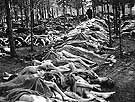
|
|
|

|

|

|

|
|
Click on an image to see a larger, more detailed picture.
|
|
|
|
|
| 1945: Liberation and Rebuilding |

|
pg. 599 |

|
|
|
|
| |
 Forsaken humanity: The painter Gideon impressionistically captures the surreal horrors that greeted Allied troops who liberated concentration camps as they drove eastward.
Forsaken humanity: The painter Gideon impressionistically captures the surreal horrors that greeted Allied troops who liberated concentration camps as they drove eastward.
Photo: Gideon
|
 The dirty bandages on the face of this Bergen-Belsen survivor provide evidence of the abuse she received during her imprisonment. Many of the camp's "survivors" continued to die even after the camp's liberation. A British soldier remembered that many of the former inmates "collapsed as they walked and fell dead." About 14,000 prisoners died from April 15 to June 20.
The dirty bandages on the face of this Bergen-Belsen survivor provide evidence of the abuse she received during her imprisonment. Many of the camp's "survivors" continued to die even after the camp's liberation. A British soldier remembered that many of the former inmates "collapsed as they walked and fell dead." About 14,000 prisoners died from April 15 to June 20.
Photo: AP/Wide World
|
 When the British liberated the Bergen-Belsen, Germany, concentration camp on April 15, 1945, they discovered tens of thousands of unburied bodies abandoned by the Germans. The British had no choice but to bury the corpses in mass graves. Curtis Mitchell, an American who visited the camp at this time, described the Germans who were forced to load the bodies into trucks in preparation for mass burial as behaving "just as if they were dumping garbage."
When the British liberated the Bergen-Belsen, Germany, concentration camp on April 15, 1945, they discovered tens of thousands of unburied bodies abandoned by the Germans. The British had no choice but to bury the corpses in mass graves. Curtis Mitchell, an American who visited the camp at this time, described the Germans who were forced to load the bodies into trucks in preparation for mass burial as behaving "just as if they were dumping garbage."
Photo: Archive Photos
|
|

|

|

|

|
 March 29, 1945: The Red Army takes Danzig.
March 29, 1945: The Red Army takes Danzig.
|
 March 30, 1945: Jewish women being led to their deaths at the Ravensbrück, Germany, camp grapple with their SS guards. Nine of the women escape but are recaptured and murdered with the rest.
March 30, 1945: Jewish women being led to their deaths at the Ravensbrück, Germany, camp grapple with their SS guards. Nine of the women escape but are recaptured and murdered with the rest.
|
 March 30, 1945: Soviet troops enter Austria.
March 30, 1945: Soviet troops enter Austria.
|
 April 1945: In a transparent attempt to save himself, Heinrich Himmler tells Norbert Masur, a representative of the Geneva-based World Jewish Congress, that Jews and National Socialists should "bury the hatchet"; See April 20, 1945.
April 1945: In a transparent attempt to save himself, Heinrich Himmler tells Norbert Masur, a representative of the Geneva-based World Jewish Congress, that Jews and National Socialists should "bury the hatchet"; See April 20, 1945.
|
 April 1945: Because there is no longer a way for prisoners at Mauthausen, Austria, to wash, lice infestation there is out of control.
April 1945: Because there is no longer a way for prisoners at Mauthausen, Austria, to wash, lice infestation there is out of control.
|
 Early April 1945: The SS evacuates thousands of Jews--mostly on foot--as Allied and Soviet forces press in from the east and west. Evacuees are taken to camps at Bergen-Belsen, Germany; Dachau, Germany; Ebensee, Austria; Leitmeritz, Czechoslovakia; and Theresienstadt, Czechoslovakia. The operation is rife with daily beatings and murders as well as deaths from starvation and typhus. Thirteen hundred Jews are evacuated on foot from Vienna; only 700 will reach their destination, the Gusen, Austria, camp, alive.
Early April 1945: The SS evacuates thousands of Jews--mostly on foot--as Allied and Soviet forces press in from the east and west. Evacuees are taken to camps at Bergen-Belsen, Germany; Dachau, Germany; Ebensee, Austria; Leitmeritz, Czechoslovakia; and Theresienstadt, Czechoslovakia. The operation is rife with daily beatings and murders as well as deaths from starvation and typhus. Thirteen hundred Jews are evacuated on foot from Vienna; only 700 will reach their destination, the Gusen, Austria, camp, alive.
|
|
|
|
|
| 1945: Liberation and Rebuilding |

|
pg. 599 |

|
|
The Holocaust Chronicle
© 2009 Publications International, Ltd.
|
|
